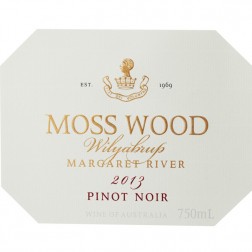Moss Wood 2013 Pinot Noir
Wine Facts
| Median Harvest Date: | 15/02/2013 |
| Bottled: | 25/11/2014 |
| Released: | 21/09/2015 |
| Yield: | 4.55 t/ha |
| Mean Harvest Ripeness: | 13.8° Be |
| Alcohol: | 14% |
| Vintage Rating: | 10/10 |
Tasting Notes
The final wine has a bright, medium to deep ruby colour. One thing is for sure, it absolutely says “Pinot Noir” on the nose. The fruit aromas are lifted and scented, suggesting strawberries, strawberry jam, cherry, plum and musky notes like quince jelly. Although it’s fresh it is also complex, with the background revealing some quite earthy notes like leather and soil. In addition, there are some restrained, charry oak characters.
Moss Wood 2013 Pinot Noir – Jancis Robinson – jancisrobinson.com
Sweet and round with sufficient freshness but not that much subtlety. Quite evolved with no tannin to speak of. Lots of pleasure but it’s a bit simple. 16-
Moss Wood 2013 Pinot Noir – James Suckling – jamessuckling.com
A tangy red with dried berry and vanilla character. Full body, soft and friendly, if obvious.
Moss Wood 2013 Pinot Noir – Lisa Perrotti Brown MW – Robert Parker Wine Advocate, March 2016
“The 2013 Pinot Noir is pale ruby-purple in color with ripe cherry and raspberry notes plus spiced mulberry and underbrush hints. Light, elegant and pretty with very fine tannins, this Pinot Noir has a lovely fresh finish.” 90 Points
Moss Wood 2013 Pinot Noir – James Halliday - The Wine Companion
I cannot remember a Moss Wood Pinot with as much varietal character as this wine. Global warming? This canary in the coal mine is hopping about brightly, whistling loud and clear. It would be fascinating to secrete it in a blind tasting of pinots of Australia’s top regions, and throw…
Moss Wood 2013 Pinot Noir – John Lewis – Newcastle Herald
THE Moss Wood 2013 Wilyabrup Pinot Noir shines ruby red in the glass and displays gamey scents. The front of the palate delivers ripe cherry flavour and the middle palate introduces plum, cloves and anise fruit characters integrated with restrained savoury oak. Dusty tannins come into play at the finish….
Vintage Notes
We had an odd start to the summer of 2013. On 30th November 2012, we had a very intense storm with strong winds and hail doing a significant amount of damage, just about identical to a similar event in the beginning of December 1996. All varieties experienced major losses, although the Pinot Noir got off lightly, being only 30% down. After this rocky start, things improved until by the last 2 days of December we reached 40⁰C. That set the theme for the rest of season, although the mercury didn’t return to quite those levels again and we had warm to hot weather all the way through to the end of February.
No surprise then picking commenced 8 days early on 13th February and ripeness of 13.7⁰ Baume was slightly above average. The fruit condition was good, with no disease or damage and flavours were excellent. Things were all in our favour.
Production Notes
All the fruit was hand-picked, sorted, destemmed and then placed in small, open tanks for fermentation. Each batch was soaked at 8⁰C for 72 hours then seeded with selected yeast strains for fermentation and hand plunged 3 times per day. After 12 days on skins the tanks were drained and pressed and after malolactic fermentation the wine was racked into barrel. All barrels were 225 litre French oak and 14% were new. After 18 months the barrels were blended together and the wine was then sterile filtered and bottled on 25th November, 2014.
Cellaring Notes
Like all good Pinot Noirs, the palate is a generous combination of red and dark fruit flavours that are bright and long and lifted, rather than heavy. Underneath this sits a firm acidity and tannin that give the wine the spine and concentration to be a good cellaring prospect. Typically, our Pinot Noir wines retain their fleshy, enjoyable fruit characters until around 10 years old and after this, the secondary characters begin to take hold. Typically this is exemplified by leathery, meaty notes that build the depth of both nose and palate. At the same time the structure begins to soften, and as the impact of tannin and acidity diminish, rounding out the palate and really improving drinkability. Full maturity will be reached well beyond 20 years.

